Acer R7 Review: Something Different
by Jarred Walton on August 15, 2013 12:45 AM ESTI’m going to stuff all of the benchmarks onto one page for this review; there’s really nothing noteworthy about the performance of the R7, at least on the CPU and graphics side of things. Battery life and display quality are a bit more important, but given the timeliness of this review (or the lack thereof), most of what we wanted to say was covered on the previous pages. So, here are the benchmarks, using our updated 2013 mobility suite. I’ll save a bit of short commentary for after the break.
First, here’s a quick overview of the laptops we’re including in our graphs. With the update to our 2013 mobile test suite, we’re somewhat at the mercy of our results database. Most of our comparisons that are meaningful are going to be with Ultrabooks, and given that were dealing with basically Ultrabook hardware the Acer R7 posts similar performance. We tossed in the MSI GX60 Richland APU notebook as a comparison, not because the notebooks are similar but because the A10-5750 APU more or less competes with Ivy Bridge ULV processors. Note that we did not run every benchmark on every laptop, so some charts might be missing certain laptops.
| Specifications of Benchmarked Laptops | ||||||
| Laptop | CPU | GPU | Storage | RAM | LCD | Battery |
| Acer R7-571-6858 | Intel Core i5-3317U | HD 4000 | 500GB HDD + 24GB SSD | 1x4GB + 1x2GB | 15.6” 1080p Glossy AHVA Touchscreen | 4-cell 54Wh |
| Acer S7-391-9886 | Intel Core i7-3517U | HD 4000 | 2x128GB RAID 0 SSDs | 2x2GB | 13.3” 1080p Glossy IPS Touchscreen | 4-cell 35Wh |
| Acer S7-392-9890 (Preview) | Intel Core i7-4500U | HD 4400 | 2x128GB RAID 0 SSDs | 2x4GB | 13.3” 1080p Glossy IPS Touchscreen | 4-cell 46Wh |
| AMD Kabini | AMD A4-5000M | HD 8330 | 256GB SSD | 1x4GB | 14” 1080p Matte IPS | 4-cell 45Wh |
| Apple MacBook Air 13 (2013) | Intel Core i5-4250U | HD 5000 | 128GB SSD | 2x2GB | 13.3” 1440x900 Glossy TN | 4-cell 54Wh |
| Clevo W550EU (Mythlogic) | Intel Core i5-3340M | HD 4000 | 256GB SSD | 2x4GB | 15.6” 1080p Matte IPS | 6-cell 62-Wh |
| HP Spectre XT TouchSmart | Intel core i7-3517U | HD 4000 | 500GB HDD + 32GB SSD | 2x4GB | 15.6” 1080p Glossy IPS Touchscreen | 4-cell 48Wh |
| Lenovo ThinkPad X1 Carbon | Intel Core i5-3427U | HD 4000 | 180GB SSD | 2x2GB | 14” 1600x900 Glossy TN Touchscreen | 4-cell 45Wh |
| MSI GE40 | Intel Core i7-4702MQ | HD 4600 / GTX 760M | 128GB SSD + 750GB HDD | 1x8GB | 14” 1600x900 Matte TN | 6-cell 65Wh |
| MSI GX60 | AMD A10-5750 | HD 8650G | 750GB HDD | 1x8GB | 15.6” 1080p Matte TN | 9-cell 87Wh |
| Toshiba KIRAbook | Intel Core i7-3537U | HD 4000 | 256GB SSD | 2x4GB | 13.3” 2560x1440 Glossy IPS Touchscreen | 4-cell 52Wh |
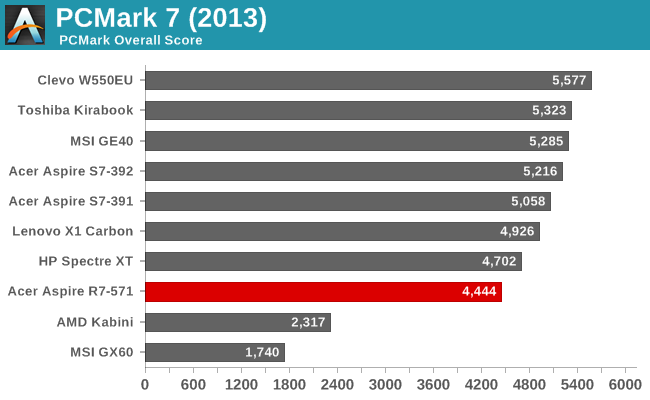
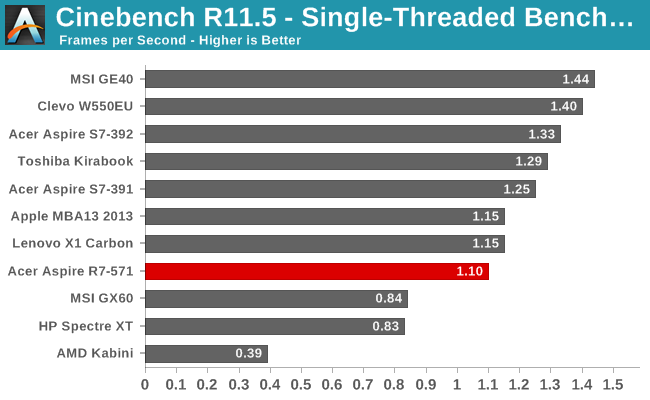
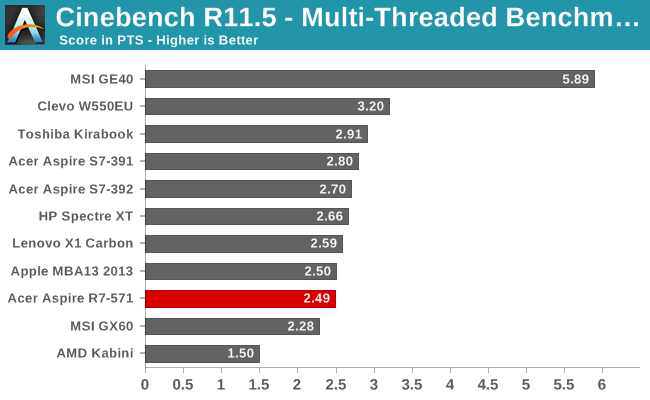
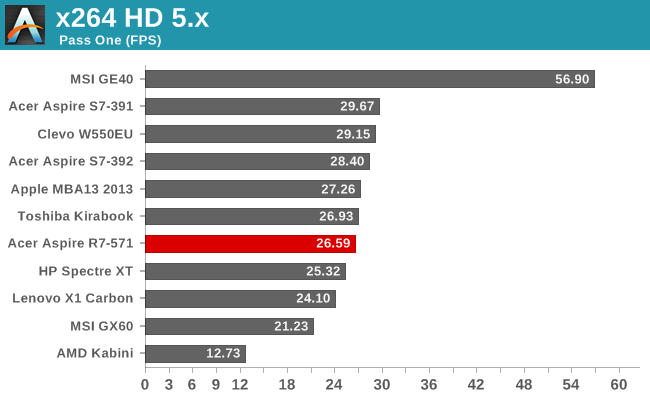
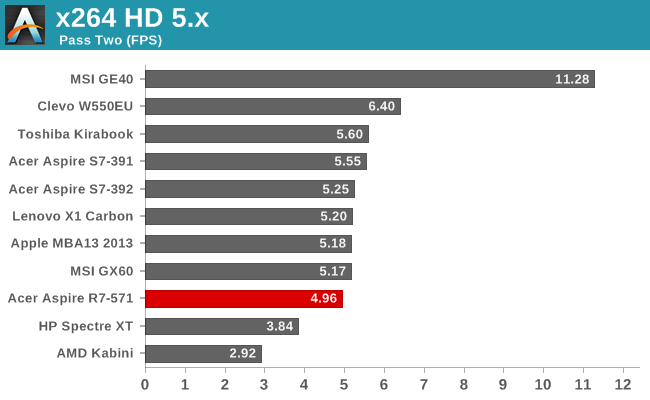
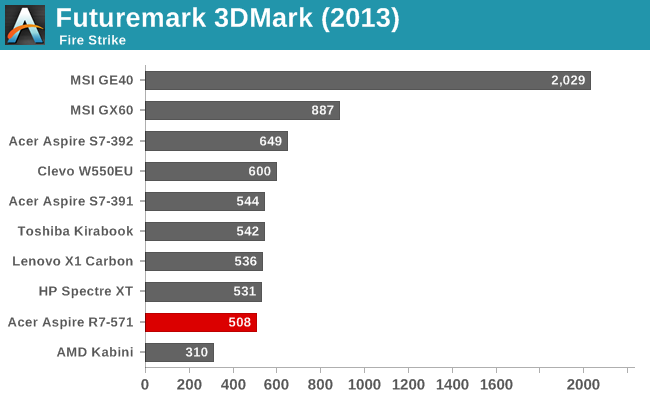


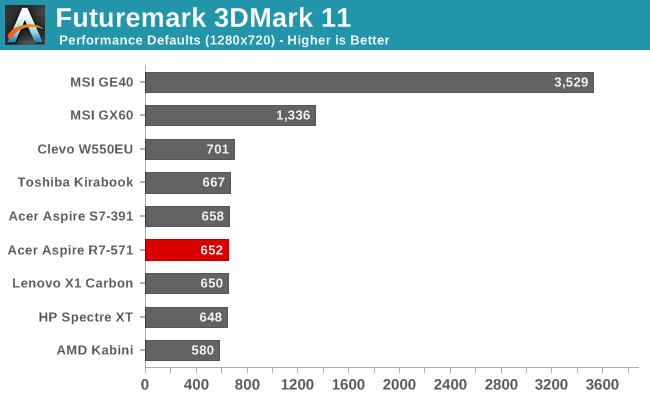
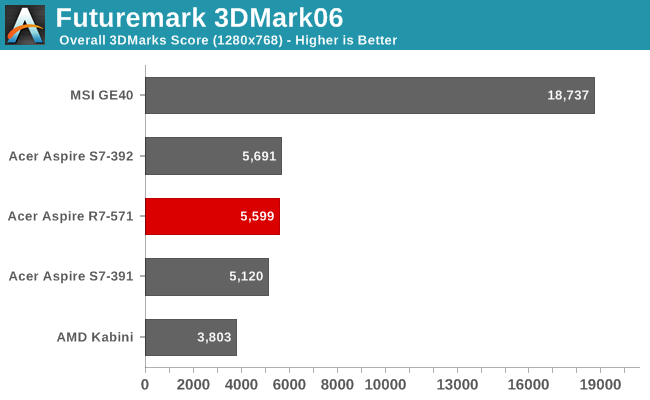

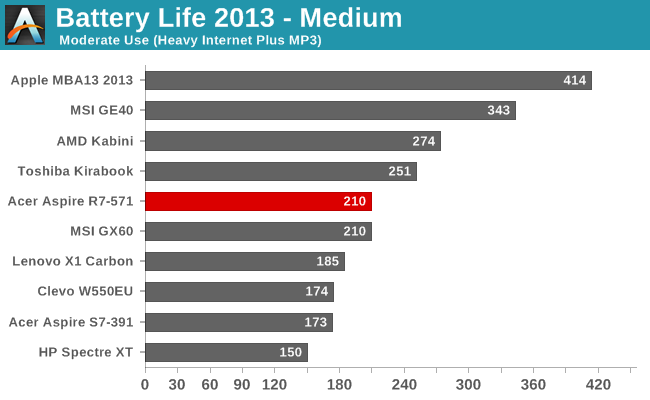
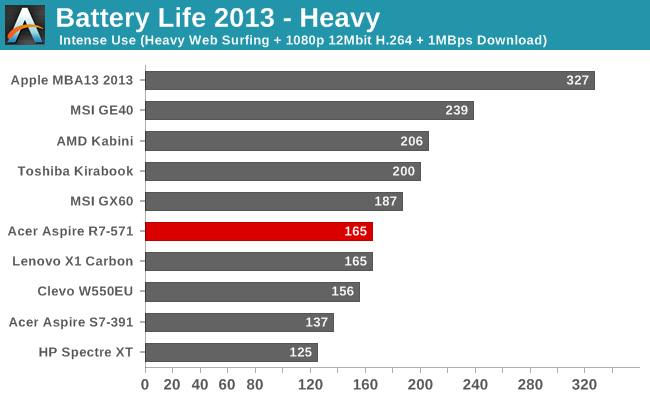
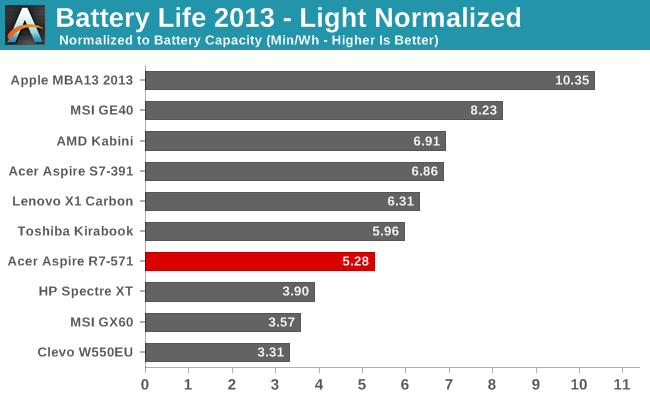
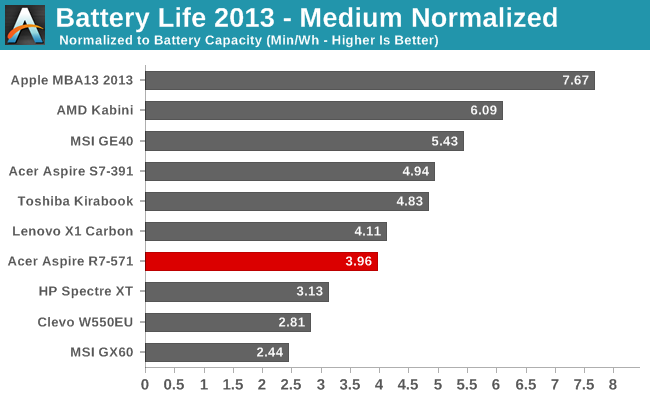
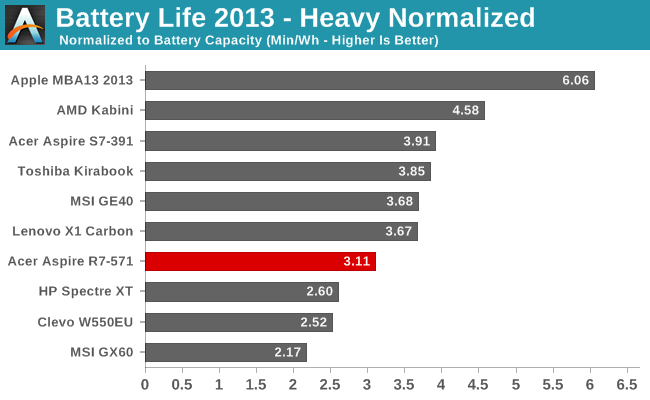
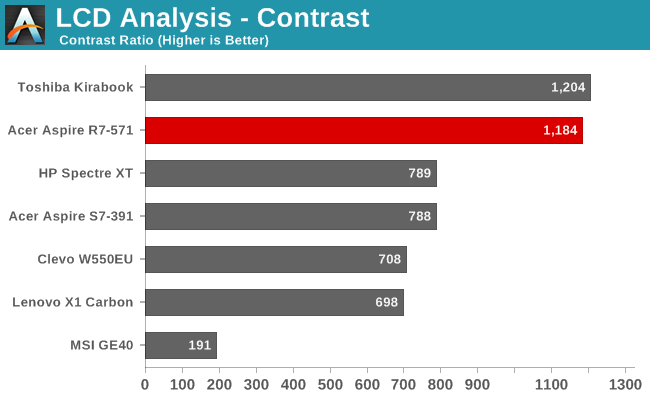

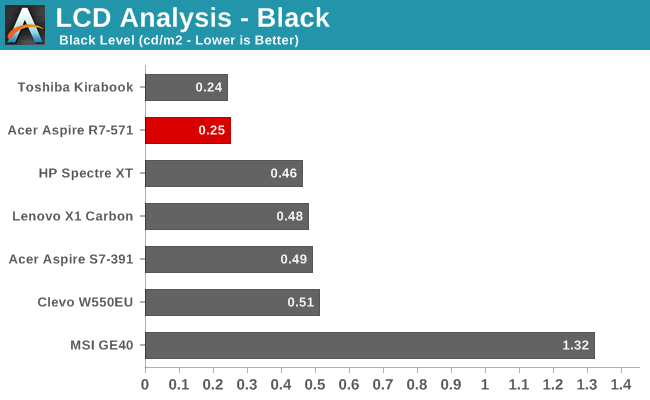
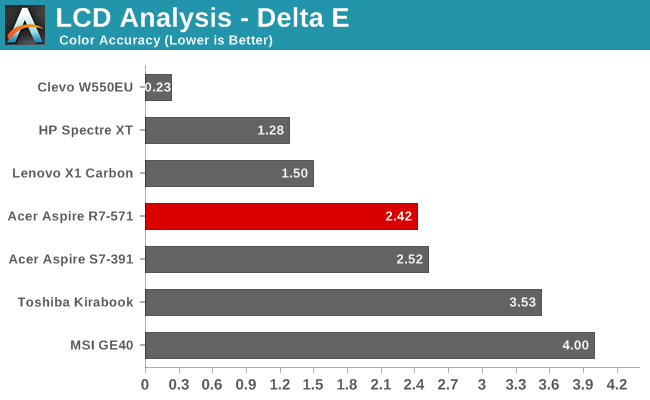
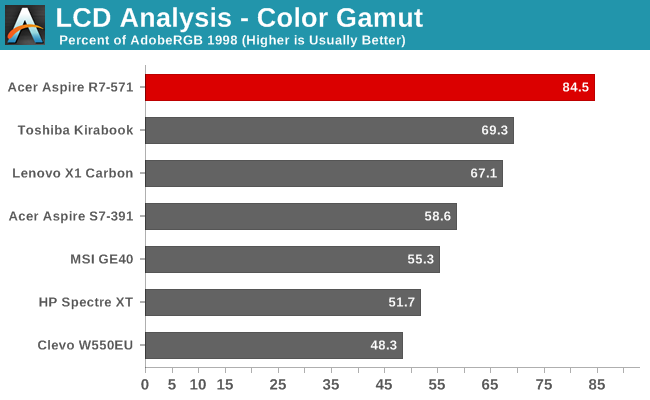
Whew! That’s a lot of benchmarks, and there are even more results in Mobile Bench – like if you really want to know how the R7 handles our gaming suite, for example, it’s there! If you don’t want to look but want a short summary, only one game gets above 10FPS at the Enthusiast settings, and just barely; with Mainstream most of the games fall in the 10-20FPS range, so basically unplayable. Even our Value gaming settings are mostly too much for the HD 4000, though most of the Windows 8 games in the Store are far less demanding and will run just fine – no surprise given most of those are targeting Windows RT, which means GPUs that are often less than half as fast as the HD 4000.
Elsewhere, CPU performance is about where you’d expect it: lower than Core i7 ULV/ULT, and similar to other Core i5 ULV parts. The hybrid storage solution means that PCMark7 doesn’t score quite as well as pure SSDs, but it’s still a huge step up from what you’d get from a pure HDD setup (e.g. GX60). Since I just mentioned the GX60, it’s also interesting to note that Core i5 ULV generally posts better CPU performance than AMD’s Richland APUs – though the second pass of x264 HD at least put AMD slightly ahead. GPU performance is nothing to write home about; it’s more than sufficient for running most Windows tasks, but anything graphically intensive is best off served by a dedicated GPU (or at the very least Intel’s Iris HD Graphics Iris Pro).
Battery life isn’t particularly stellar, but we’ve also seen worse – sometimes much worse. Realistically, four hours of light use is possible off a single charge, while heavier workloads will bring you closer to 2.5 hours. That puts the R7 slightly ahead of the Lenovo X1 Carbon in most tests, but only thanks to its higher battery capacity. In terms of normalized battery life, the R7 places fourth from last of the tested notebooks, and given that Clevo typically doesn’t optimized very well for power use and the MSI GX60 is classified as a gaming notebook, only the win over the HP Spectre XT TouchSmart is really worth mentioning. When we start to look at Haswell-based notebooks, even though Ivy Bridge was pretty good it looks pretty poor in light of what’s now available. Apple’s MacBook Air 13 runs at different OS, but the MSI GE40 has a quad-core Haswell CPU and a slightly larger battery, with about 50% more battery life than the Acer R7.
Wrapping up the benchmarks, as I mentioned before, the one standout item in the R7 is the display. Contrast is excellent, and color quality is at least decent – the 85% color gamut is actually a bit overblown, however, as some of the colors are actually outside of the Adobe RGB 1998 color space while others fall far short (green in particular is lacking). Still, the great viewing angles offered by AHVA combined with good overall performance definitely deserve commendation.










113 Comments
View All Comments
ZeDestructor - Thursday, August 15, 2013 - link
It does indeed. And so far, I haven't seen a single ultrabook with VGA (DIE VGA, DIE, TOGETHER WITH YOUR HATEFUL BROTHER, DVI!)Even projectors have moved on to miniDP/HDMI these days, with VGA firmly legacy, but of course, cheapskate business will try to save as usual, so you'll need an adapter for their 800x600 projector....
JarredWalton - Thursday, August 15, 2013 - link
I understand it might look like DisplayPort, but it's not. Here's a link to the data sheet, which I admit isn't as easy to find on Acer's site as you might expect:http://us.acer.com/ac/en/US/content/model-datashee...
Note how it says, "VGA: Yes".
jaydee - Thursday, August 15, 2013 - link
I did actually go to the spec sheet on Acer's site before posting, but I still think it's incorrect. Compare the following images:http://upload.wikimedia.org/wikipedia/commons/thum...
http://www.uapple.com.ua/wp-content/uploads/2010/0...
If it were mini-VGA, you should see the 7 individual pins in the bottom of the port, no?
JarredWalton - Thursday, August 15, 2013 - link
There is no standard for mini-VGA -- it's a proprietary thing, so how you implement is up to you. I think there might even be a mini-VGA to VGA cable with the R7.jaydee - Friday, August 16, 2013 - link
After some googling, that port is actually called the "Acer Converter Port", and with proprietary cables, you can connect VGA, USB or ethernet to it. According to Acer's website, it is the exact same physical port as mini-DP. Hella-confusing if you ask me.http://acer.custhelp.com/app/answers/detail/a_id/3...
ZeDestructor - Friday, August 16, 2013 - link
Just... why.... Why not just use Thunderbolt?JarredWalton - Friday, August 16, 2013 - link
From the page you linked:Can I connect my Aspire R7 series to a LAN or VGA port?
To connect to a LAN or connect to a VGA monitor, you first have to connect the Acer Converter cable to the Acer Converter port on your computer. The Acer converter cable is a one-to-three cable that provides an Ethernet port, VGA port and an additional USB port.
Can I connect a DisplayPort monitor to the Acer Converter Port?
The Acer Converter Port uses the same physical port as a Mini DisplayPort, but is designed to connect to an Acer proprietary cable. If you connect a DisplayPort monitor, Acer cannot guarantee the functionality of the monitor. No damage should occur to either monitor or notebook by connecting a Mini DisplayPort cable."
Ummm... so is it a DisplayPort connector, or is it just the same shape? Because if it's not DisplayPort it won't work at all, but if it is then it should always work. And of course, Thunderbolt also uses the same style of connector, right? I don't immediately see any Thunderbolt chips in the internal images, but perhaps the chip is on the other side of the motherboard. I'm guessing more likely is that it's not TB or DP but something altogether different.
ananduser - Thursday, August 15, 2013 - link
I don't like this machine Jarred, not one bit. I'll also agree with you that Win8 is a yin/yang affair for the moment; personally I'll give MS one more year before I judge Metro on a desktop - waiting for one more iteration of Win8 devices with the expected CPU improvements in the industry. Until then, ClassicStart only.Now Jarred, how about reviewing some Vaios, the S7(preferably the Euro version or both). I've yet to read a review on a Vaio(Pro and Duo) that actually dives into the Triluminous/Quantum Dot tech Sony has developed. Only Anandtech™ can do that.
ZeDestructor - Thursday, August 15, 2013 - link
Anandtech hasn't reviewed any Sony devices for the past year at least... I'm still waiting for an Xperia Z review myself (hint, hint Brian Klug!)djc208 - Friday, August 16, 2013 - link
True, but that's kind of like saying Ferrari isn't as good as Honda because how many people own Ferraris.The Surface Pro is a laptop without the keyboard, and priced similarly. Its not really competition for iPads and Android tablets at half the price and functionality. The surface RT looses the benfits of Windows 8, without the apps and ecosystem of either iOS or Android for the same or more money. Besides the confusion over what RT can and cannot do. And the Vivo was cheap crap that was still too expensive for what you got.
I don't think Windows 8 is perfect, nor do I expect 8.1 to fix everything, but Microsoft has most of the pieces to bring people back to Windows devices, and as usual they just can't execute.